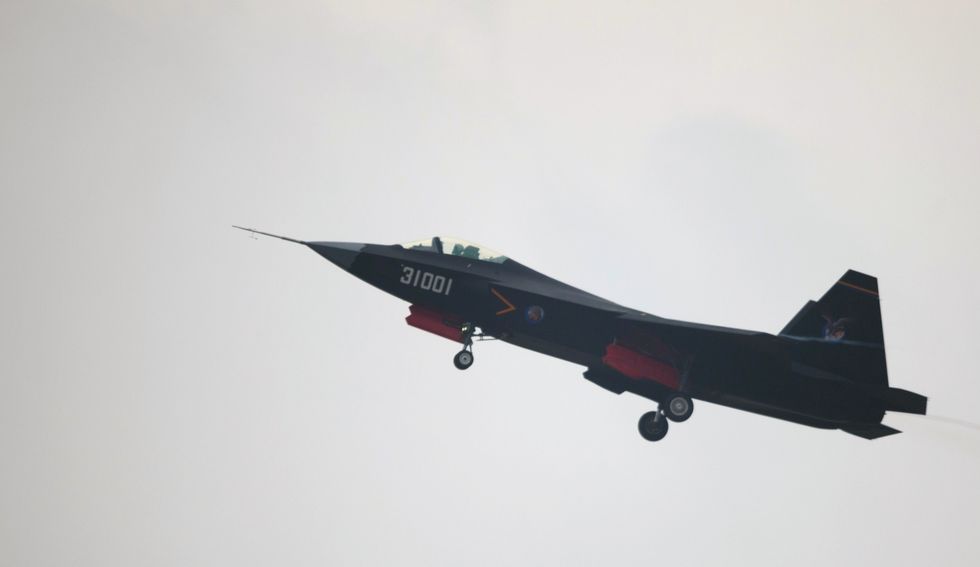
Observers spotted China’s FC-31 “Gyrfalcon” fighter jet at a naval aviation training facility.
The FC-31 has been around for nearly 10 years without securing a role in the Chinese military.
The jet will likely replace China’s current carrier fighter, the Shenyang J-15.
A fighter jet that China’s military once considered a white elephant appears to have finally secured a role as the country’s newest carrier fighter.
Observers recently spotted the Shenyang Aircraft Corporation FC-31 Gyrfalcon (formerly known as the J-31), which has been in development since the early 2010s, at a naval aviation training facility in Wuhan. The fighter bears a strong resemblance to American fifth-generation fighters like the F-22 Raptor and F-35 Joint Strike Fighter.
The fighter was parked on an enormous, landlocked model of an aircraft carrier near a pair of mockups of the Chinese Navy’s current strike fighter, the J-15 “Flying Shark,” as well as a mockup of a Z-8 carrier-based helicopter.
The FC-31 first appeared in 2012 with the designation J-31; in time, the F-31 designation (initially applied to export models) overtook the name. The fighter kept a low profile throughout the last decade, with observers believing the Chinese Air Force and Navy weren’t particularly interested in the design and its reportedly weak engines.
Nine years is a long time in the world of the Chinese military, and now, the FC-31 may finally be nearing production. In 2020, Pop Mech reported there were indications the FC-31 could enter service with the Chinese Navy as a carrier-based fighter, now called the “J-35.”
The new fighter’s emergence at the Wuhan test facility is a clear sign the plane is headed to sea, but we don’t yet know if the fighter’s designation is really J-35. For now, we’ll keep calling it the FC-31.
The front end of the FC-31 resembles the F-35, while it has the flat tail and twin engines of the F-22. The Chinese fighter also features internal weapons bays, and the robust tricycle landing gear with two wheels up front suggests it’s designed for carrier use.
China’s existing carriers, Liaoning and Shandong, fly the J-15 “Flying Shark” strike fighter. The J-15 is derived from the fourth-generation Sukhoi Su-33, one of Russia’s two carrier-based fighters. The fifth-generation FC-31 would be a definite upgrade, boosting the air wings of both carriers with a stealthy fighter.
The FC-31 will also probably fill the flight decks of China’s third carrier under construction, tentatively named 003, from the outset. Ultimately, China might operate as many as six carriers, with FC-31s flying from the decks of at least four, if not all of them.
The FC-31 fighter probably isn’t the F-35’s equal, but it’s a significant upgrade from the J-15, and that will make the Chinese Navy happy. China is taking a pragmatic approach to the dangerous—and expensive—world of naval aviation. Instead of rushing to match the U.S. Navy from the outset, it’s learning to crawl, and then walk, and then eventually run. It’s an approach that’s likely to pay off for decades to come.
It is very likely that the J-31 will be inducted as a carrier-based naval fighter. In an interview with China’s state-run media, FC-31’s chief designer Sun Cong expressed that the aircraft would follow his J-15 onto China’s aircraft carriers. However, officials from AVIC only said that the aircraft was intended for export as a competitor to the F-35. There has also been reports that the PLAAN has urged Shenyang to develop a carrier-compatible version of J-31.
In 2015, Jiangsu A-Star Aviation Industries Company marketed its EOTS-86 infra-red search and track as a possible addition to the J-31. An improved prototype, with modifications to the vertical stabilizers, wings, and airframe, an electro-optical targeting system, a larger payload, improvements in stealth, and upgraded electronics, made its maiden flight in December 2016.
In November 2018, an Aviation Week article stated that the FC-31 program has received government funding and is being sought after by both the PLANAF and PLAAF, according to official sources. In June 2020, reports surfaced that a third variant of FC-31, albeit a more production-ready version with smoother lines, bigger radome for bigger radar, and a closer alignment of control surfaces for reduce radar signature, has been developed. The “new fighter’ has been referred to by some as J-35.
Recent updates (2020)
Payload
The maximum take-off weight of this J-31 increased from 25,000 kg to 28,000 kg.[53]
Engines
Shenyang Aircraft Corporation has officially confirmed that J-31 is installing WS-19 engine, which has a maximum thrust of 12 tons, compared to WS-13 whose thrust is 9 tons. The total thrust of the jet has been increased from 18 tons to 24 tons. The maximum range of this jet was also extended to 1250 km. It can also cruise at supersonic speed.
Stealth
The J-31 is now using stealth coatings instead of “baked in” fiber-mat stealth.
Specifications (estimated)
Because the aircraft is in development, these specifications—based on available imagery—are approximate and preliminary.
General characteristics
Crew: one (pilot)
Length: 17.3 m (56 ft 9 in)
Wingspan: 11.5 m (37 ft 9 in)
Height: 4.8 m (15 ft 9 in)
Wing area: 40 m2 (430 sq ft)
Max takeoff weight: 28,000 kg (61,729 lb)
Powerplant: 2 × WS-19 afterburning turbofans, 110 kN (24,000 lbf) thrust each
Maximum speed: 2,200 km/h (1,400 mph, 1,200 kn)
Maximum speed: Mach 1.8
Combat range: 1,250 km (780 mi, 670 nmi) on internal fuel, or 2,000 kilometres (1,200 mi) with external tanks
Armament
Hardpoints: 6 x external, and internal bay with a capacity of up to 8,000 kilograms (18,000 lb), including 2,000 kilograms (4,400 lb) internally
Missiles:
Air-to-air missiles:
12 x medium-range
Air-to-ground missiles:
8 x supersonic
Bombs:
8 × 500 kg deep-penetration bombs
30 x smaller bombs
Avionics
KLJ-7A AESA radar
Distributed aperture system (DAS) optical early-warning system
Electro-optical targeting system (EOTS)